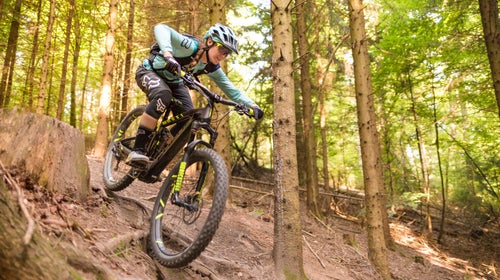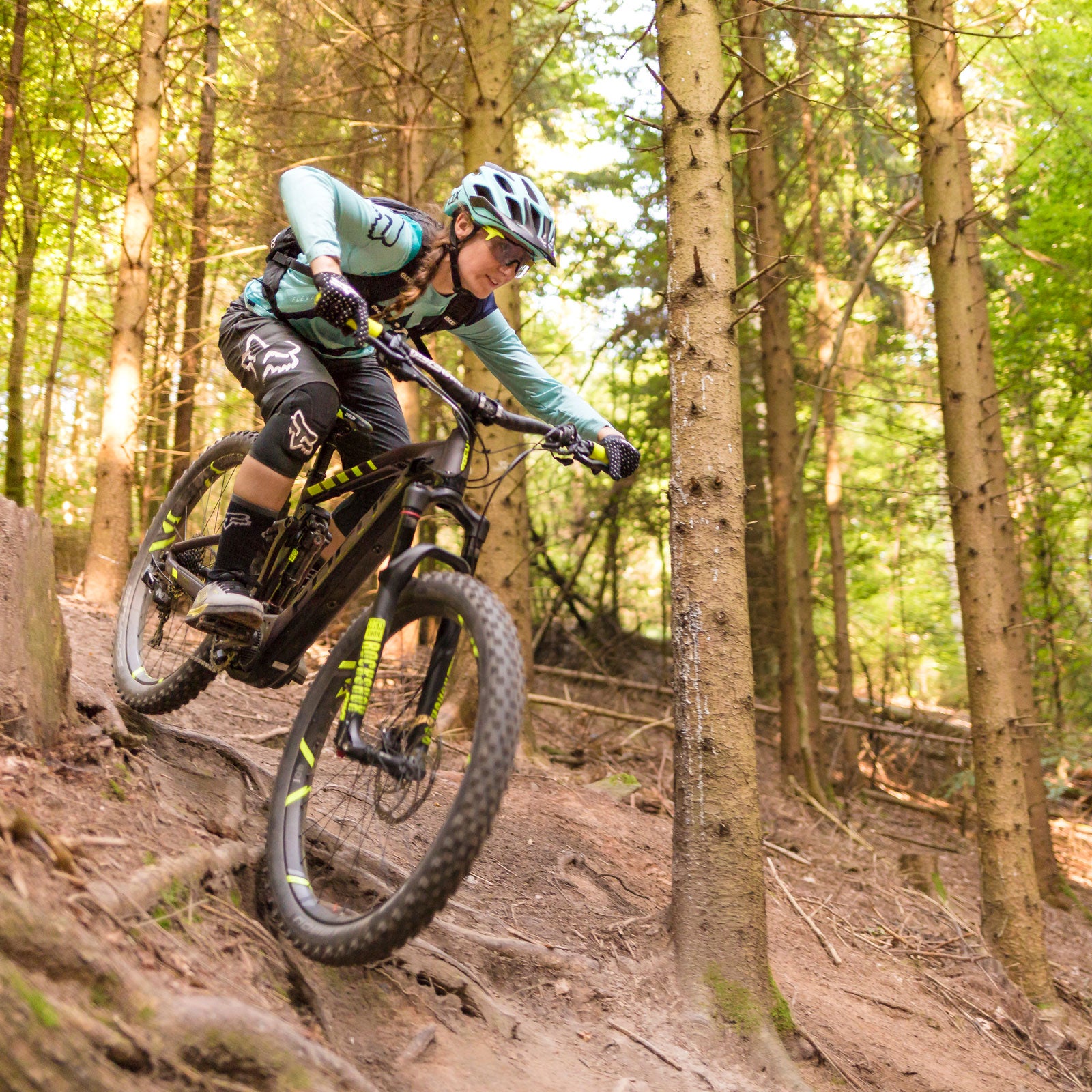IÔÇÖm continually shocked at how much disdain and vitriol e-bikesÔÇöespecially the mountain varietyÔÇöelicit. If you raise the topic among a group of cyclists, as I did recently at ║┌┴¤│ď╣¤═°ÔÇÖs annual bike test, youÔÇÖre sure to get an earful about how pedal-assist bikes are making the world a lazier place, causing all manner of trail conflicts and╠řtrail closures, and generally just ruining cycling. My position: Calm down, people. WeÔÇÖre talking about bicycles, not Satan.╠řThen╠řI usually send naysayers off to ride one of these machines. When they return, theyÔÇÖre inevitably grinning ear to ear.
ThatÔÇÖs because, like it or not, e-bikes are fun to ride. Long, slow climbs become quicker. Lunchtime rides become more interesting because╠řyou can ride farther and see trails that otherwise wouldnÔÇÖt have been possible in such a short time. And whole new trail systems are accessible as the assist opens up terrain that would be too steep, loose, rocky, or brutal on a standard pedal bike. In short, rather than be afraid of e-mountain bikes, we should see them for╠řwhat they are: a new tool. In the same way youÔÇÖd choose an enduro bike for shredding supergnar╠řdescents or a cross-country bike for all-day endurance epics, an e-mountain bike╠řis simply another arrow in the quiver for situations when standard pedal bikes might not be as much fun.
For clarity, the e-mountain bikes in this review are electric-motor-equipped bicycles that only go forward if you pedal them. Officially, they are categorized as Class 1 e-bikes, which means they have no throttle and a top-assisted speed of 20 miles per hour. (Class 2 and Class 3 varieties have throttles and/or different top-assist speeds. WeÔÇÖre limiting our coverage to Class 1 because most of the advocacy for trail use is currently for these models.) Though critics like to try and characterize all e-bikes as motorcycles, this couldnÔÇÖt be further from reality.╠řAll of these bikes generate less than one horsepower, and they do it only when you are pedaling, akin to riding with a strong tailwind.
I took a fleet of the latest out on a range of trails throughout New Mexico and was amazed by how much these machines have advanced since my first ride back in 2013. Like all technology, these bikes are going to continue improving. But if youÔÇÖre in the market and can swallow the high price tag, I feel they have come far╠řenough that theyÔÇÖre╠řwell worth buying.╠ř
Specialized╠řS-Works Turbo Levo ($12,050)
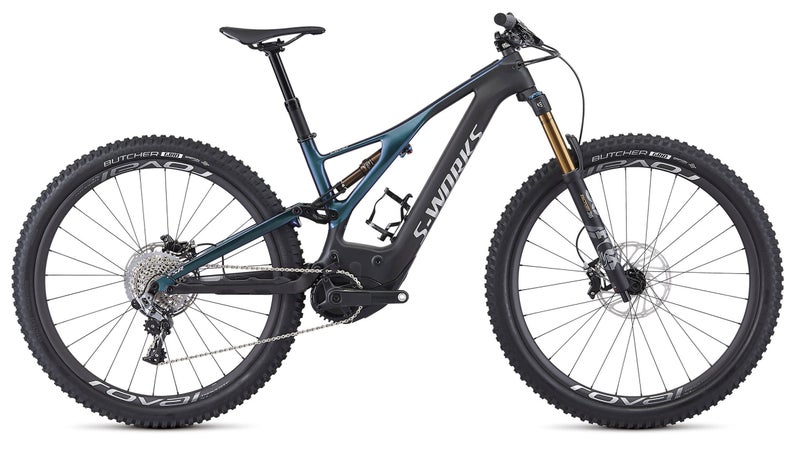
The new ╠řis effectively the 2019 Stumpjumper equipped with 29-inch wheels, a Brose motor, and a built-in 700-watt-hour╠řrechargeable battery. I start here because it was my favorite, though itÔÇÖs also true that itÔÇÖs the most expensive in the test by a wide margin. With 150 millimeters of travel on a full carbon frame and carbon wheels, this bike approaches what unassisted downhill bikes weighed (45.1╠řpounds╠řfor a size medium) and felt like a decade ago, except╠řthe motor gives you extra power when you need and want it.
The Brose motor is probably the least seamless in this review, meaning it feels a little jerky and powerful when it engages. However, it is also the quietest, which I appreciate above almost everything when IÔÇÖm in the woods. Power levels are indicated by a series of LED panels built into the top tube, not a display on the handlebars, which makes gauging a little more difficult╠řbut not impossible. The turbo button, to give a quick boost to the top power, is a great addition, as is the walk-mode buttonÔÇöjust hold it for a one-mile-per-hour assist on hike-a-bikes. The 700wh battery is the biggest capacity on the market, which equates to longer range. And while itÔÇÖs not as easy to remove the battery as on the Intense or Trek (reviewed below), itÔÇÖs doable with the included tool. Specialized has also done a great job of building its own app to tweak power levels and diagnose problems, should they arise, as well as to help estimate range.
Otherwise, this is just a stupendously capable bike that will assist you with three╠řvarious levels of power. While the 2.6-inch tires were fine, I personally feel like the added weight of the bike feels more confident with 3-inch tread, which will fit if you choose. And the bike is not so heavy that you wonÔÇÖt be able to pedal home should the battery die. IÔÇÖve slashed plenty of╠řnasty singletrack with this bike, and while the power comes on hard, I always appreciate it. The suspension is firm and ample, and it makes the bike feel more capable than the numbers suggest. Yes, the Levo is expensive, but the truth is, you could get a less expensive╠řmodel and, thanks to the motor, still enjoy the same ride.
Pivot Shuttle ($9,999)
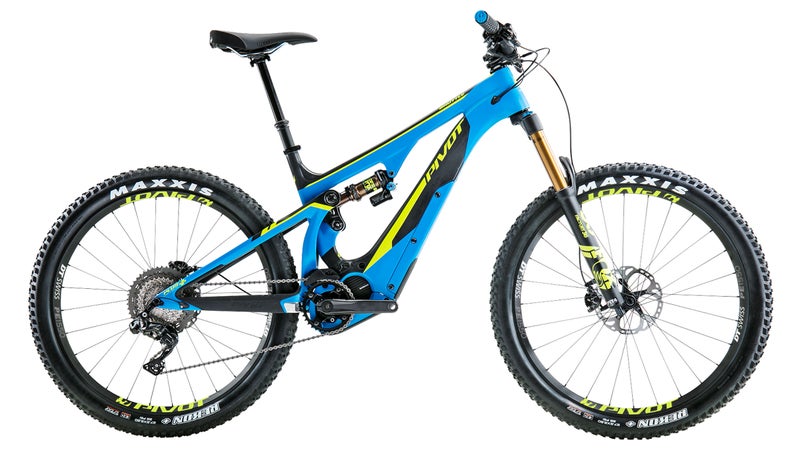
╠řhas perhaps the most normal╠řfeeling of all these bikesÔÇöand by normal, I mean least assistedÔÇöcourtesy of dialed-in geometry, a tuned motor, and a careful parts selection. Chris Cocailis, the founder and owner of Pivot, is an engineer, and his expertise in dialing in a ride is completely evident in this bike. The Shuttle feels small and maneuverable, which is exactly what I want when pushing around a 46.2-pound machine. Pivot calls this ÔÇťthe worldÔÇÖs lightest Class 1 e-mountain bike,ÔÇŁ which is perhaps true for the frame alone, but our tester was over a pound heavier than the Levo.
Pivot uses the Shimano STEPS╠ř8000 motor, which delivers three levels of power (eco, trail, and boost) and projects it on the same display Shimano specs for Di2ÔÇöa benefit for being able to see what level youÔÇÖre in at all times. The motor is smooth and feels as powerful as the Brose in top-assist mode, though the lower levels, especially eco, seem a touch underpowered. (It is possible to tweak the power levels in ShimanoÔÇÖs smartphone app.) As with many of these bikes, the STEPS 8000 seems to favor a high cadence. Whenever my pedaling speed would slow, particularly at the top of steep pitches, the motor would bog down and sometimes even cut out, leaving me hefting a very heavy bike up a steep pitch. The 500-watt-hour╠řbattery is removable, but only with tools, meaning itÔÇÖs not plug and play like the Intense and Trek (reviewed below).
Motor aside, this is a firmly rooted and very comfy trail bike, with 140 millimeters of travel out back and a 150-millimeter fork. This bike feels nearly as capable as the Specialized╠řbut a bit lower and trimmer all around (despite the extra pound). I appreciated the 2.8-inch tires, which might not sound like a lot more compared to SpecializedÔÇÖs 2.6-inchers, but the extra weight of an e-bike demands a wider tread.╠řThis bike isnÔÇÖt quite as inconspicuous as the Levo, but it rides great and, if not for the power issues in the eco mode, might have been my top pick, especially considering the (slightly) lower price tag.
Intense Tazer Pro Build ($7,590)
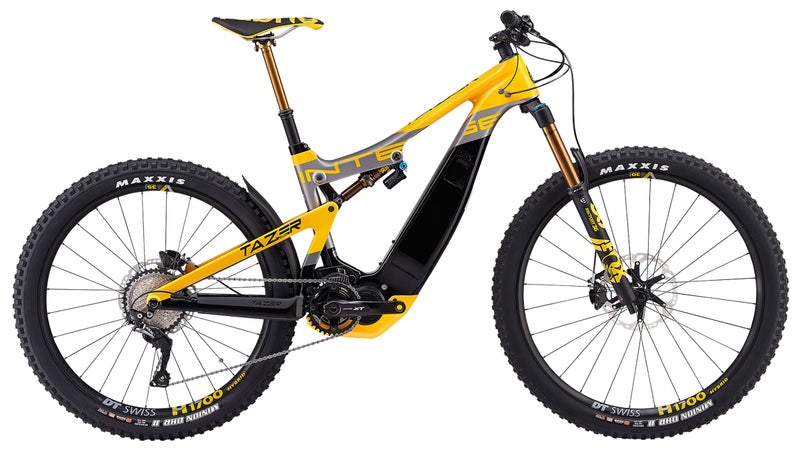
I really had to temper my misgivings about the ╠řfrom the moment I saw it, mostly for its pregnant-looking down tube and╠řthe honeybee graphics. Also, the 29-inch front and╠ř27.5-inch rear make╠řit a bit of a Frankenbike. And yet, on the trail, the Tazer stopped me dead with its rooted feel and the way it shrugged off seriously steep and ugly terrain.
Like the Pivot, this bike uses a Shimano STEPS 8000 motor. But╠řhere it felt quite different: I didnÔÇÖt experience the same cutting out at lower cadences, and the three power levels seemed better tuned to my riding style. (Again, the assist percentages can be tweaked.) I also appreciated that the 500-watt-hour╠řbattery is easily extractable from the frame;╠řsimply pop off the plastic cover on the down tube╠řand it pulls out, for both external charging as well as a battery replacement. (Intense sells external batteries in case you want to heft one along for extra range.) This motor is not as quiet as the BroseÔÇöthereÔÇÖs a constant dull whine, which ramps up as you pedal. However, with╠řIntenseÔÇÖs settings, itÔÇÖs the most intuitive and natural feeling of╠řthe group, and I found myself riding almost exclusively in eco mode because it easily got me through everything I threw at it.
Between the superslack head angle (64.9 degrees) and longer travel (a 155-millimeter rear and a 160-millimeter front), the Tazer felt like the most capable bike in the group. I chucked it╠řoff some pretty big drops, and it barely blinked. The 29- and 27.5-inch wheel combo also seems effective, rolling over pretty much everything up front but still retaining a fairly snappy feel out back. Again, the 2.6-inch tread up front feels slight diminutive, though you could easily sub in meatier rubber. The Tazer doesnÔÇÖt have the same component level and carbon wheels as the Levo, but alloy hoops and SLX seem to work just dandy in this application. Truthfully, the spec here seems dead-on, especially given that this bike costs 30 percent less than the Levo. ItÔÇÖs a rowdy shredder, if a little tall feeling. Provided you can look past the Euro graphic design,╠řand you want a bike that can tear up some serious terrain, this is worth a look. IÔÇÖd use the Tazer for shuttle runs on serious trailsÔÇöminus the car to get me there.
Trek Powerfly LT 9.7 ($5,999)
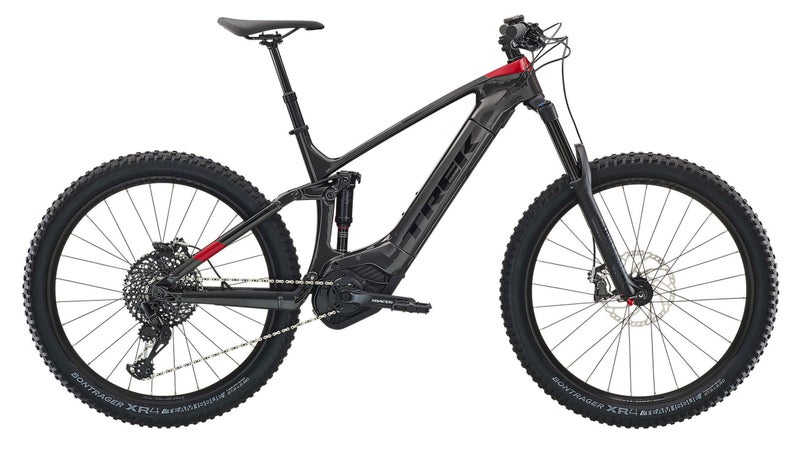
With 150 millimeters of rear travel and a 160-millimeter fork on 27.5-plus-inch╠řwheels, the is ostensibly a very capable machine. And the Bosch Performance CX motor is the smoothest of the bunch, delivering the most even (albeit the loudest)╠řpower application. ItÔÇÖs powered by a sleek 500-watt-hour╠řbattery. ItÔÇÖs also the heaviest model we tested, at 51.5 poundsÔÇöwe rode a 19.5-inch compared to╠řmediums with╠řall the restÔÇöthough weight differences arenÔÇÖt as big a deal on e-bikes as everyday pedal models.
The Bosch-motor drive delivers fluid, almost seamless assistance. Like the Shimano system, itÔÇÖs all displayed and controlled via a bar-mount display╠řand offers╠řfour levels. The eco, trail, and boost settings felt about right, but the e-mountain-bike╠řlevel, which is meant to augment power based on terrain, never quite anticipated my needs.
I love the fact that the Bosch battery can be removed with the simple turn of a key. It makes this system feel infinitely upgradeable, which is important in the age of constant technology improvement. I also appreciated that, like the Levo (and unlike Shimano STEPS), thereÔÇÖs a walk mode: hold it down╠řand the bike rolls at one╠řmile per hour to ease the burden of hiking. In short, the Bosch motor feels more refined than the ones by Shimano and Brose, though I personally overlooked the torquey feeling of the Brose in the Specialized for its veritable silence.
Motor aside, the bike feels plush and capable, perhaps partly due to the 2.8-inch house-brand tires. Again, IÔÇÖd say bigger sizes╠řare╠řa boon for e-bikes. The wheel base is longer than the others, though that sensation is partly due╠řto the larger size of the bike. Still, the longer geometry and steeper head angle (66 degrees) made this feel more trail bike than all-mountain ripper. Having said that, this is a solid all-around bike╠řburgeoned by the fact that itÔÇÖs upgradeable over time.
A Final Word
A friend said to me, ÔÇťThese new e-bikes are great, but they are basically expensive toys right now.ÔÇŁ I get his point.╠řYou can only ride e-mountain bikes╠řon half of the trails out there, likely fewer. So itÔÇÖs important to consider where and how you can use them before you make a purchase.
Yet IÔÇÖm incredibly jazzed about these bikesÔÇÖ potential. The utility aspectÔÇöfor╠řtrail building, commuting, training (think motor pacing), exploration (thereÔÇÖs nothing better than a little extra power when plowing around places youÔÇÖve never been), and flat-out capability (I╠řhauled out an elk with mine)ÔÇömakes them difficult to ignore. I also sometimes just love the speed and ease of pedaling they provide: when IÔÇÖm on a rest day but╠řstill want to get out and breathe, I grab one of these bikes and power off.
YouÔÇÖll note that I didnÔÇÖt dwell on range or battery power. ThatÔÇÖs because thereÔÇÖs not a concrete answer to how long the power on these machines will hold out;╠řit varies by terrain, rider weight, speed, pedaling style, and╠řchosen assist power. What I can say is that I took all of these bikes on three- to four-hour trail rides in the Rockies, in places with significant elevation gain and loss, and by spending most of my time in the lower-assist modes and powering up when needed, I finished with approximately 20 to 30 percent battery in each. I also think itÔÇÖs worth pointing out that╠řwhile the super-high-end builds are sweet,╠řwith their carbon frames and wheels and topmost components, given the motor assist, they probably arenÔÇÖt completely definitive the way they are in standard pedal bikes. If I were in the market, IÔÇÖd look at the least expensive builds of these bikes, with an eye to both durability and technology improvements over╠řtime.
Are e-mountain bikes╠řperfect? Not yet. But╠řthey are darn fun to ride, and╠řas weÔÇÖve seen in just a few years, they are only going to get better. For now, IÔÇÖll be blasting around the backcountry╠řfrom time to time╠řwith a big grin on my face.
